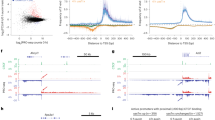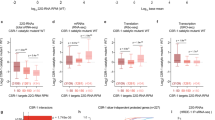Abstract
The prevalence of antisense RNA in eukaryotes is not known and only a few naturally occurring antisense transcripts have been assigned a function1,2,3,4. However, the recent identification of a large number of putative antisense transcripts5 strengthens the view that antisense RNAs might affect a wider variety of processes than previously thought. Here we show that in the model organism Neurospora crassa entrainment of the circadian clock, which is critical for the correct temporal expression of genes and their products, is controlled partly by an antisense RNA arising from a clock component locus. In a wild-type strain, levels of antisense frequency (frq) transcripts cycle in antiphase to sense frq transcripts in the dark, and are inducible by light. In mutant strains in which the induction of antisense frq RNA by light is abolished, the time of the internal clock is delayed relative to the wild-type strain, and resetting of the clock by light is altered. These data provide an unexpected link between antisense RNA and circadian timing and provide a new example of a eukaryotic cellular process regulated by naturally occurring antisense RNA.
This is a preview of subscription content, access via your institution
Access options
Subscribe to this journal
Receive 51 print issues and online access
$199.00 per year
only $3.90 per issue
Buy this article
- Purchase on SpringerLink
- Instant access to full article PDF
Prices may be subject to local taxes which are calculated during checkout




Similar content being viewed by others
References
Kumar, M. & Carmichael, G. G. Antisense RNA: function and fate of duplex RNA in cells of higher eukaryotes. Microbiol. Mol. Biol. Rev. 62, 1415–1434 (1998)
Eddy, S. R. Non-coding RNA genes and the modern RNA world. Nature Rev. Genet. 2, 919–929 (2001)
Avner, P. & Heard, E. X-chromosome inactivation: counting, choice and initiation. Nature Rev. Genet. 2, 59–67 (2001)
Sleutels, F., Zwart, R. & Barlow, D. P. The noncoding Air RNA is required for silencing autosomal imprinted genes. Nature 415, 810–813 (2002)
Ambros, V. MicroRNAs: tiny regulators with great potential. Cell 107, 823–826 (2001)
Dunlap, J. C. Molecular bases for circadian clocks. Cell 96, 271–290 (1999)
Cermakian, N. & Sassone-Corsi, P. Multilevel regulation of the circadian clock. Nature Rev. Mol. Cell Biol. 1, 59–67 (2000)
Hastings, M. H. Circadian clockwork: two loops are better than one. Nature Rev. Neurosci. 1, 143–145 (2000)
Aronson, B. D., Johnson, K. A., Loros, J. J. & Dunlap, J. C. Negative feedback defining a circadian clock: autoregulation of the clock gene frequency. Science 263, 1578–1584 (1994)
Merrow, M. W. & Dunlap, J. C. Intergeneric complementation of a circadian rhythmicity defect: phylogenetic conservation of structure and function of the clock gene frequency. EMBO J. 13, 2257–2266 (1994)
Crosthwaite, S. K., Dunlap, J. C. & Loros, J. J. Neurospora wc-1 and wc-2: transcription, photoresponses, and the origins of circadian rhythmicity. Science 276, 763–769 (1997)
Cheng, P., Yang, Y. & Liu, Y. Interlocked feedback loops contribute to the robustness of the Neurospora circadian clock. Proc. Natl Acad. Sci. USA 98, 7408–7413 (2001)
Collett, M. A., Dunlap, J. C. & Loros, J. J. Circadian clock-specific roles for the light response protein WHITE COLLAR-2. Mol. Cell. Biol. 21, 2619–2628 (2001)
Froehlich, A. C., Liu, Y., Loros, J. J. & Dunlap, J. C. White Collar-1, a circadian blue light photoreceptor, binding to the frequency promoter. Science 297, 815–819 (2002)
Denault, D. L., Loros, J. J. & Dunlap, J. C. WC-2 mediates WC-1-FRQ interaction within the PAS protein-linked circadian feedback loop of Neurospora. EMBO J. 20, 109–117 (2001)
Merrow, M. et al. Circadian regulation of the light input pathway in Neurospora crassa. EMBO J. 20, 307–315 (2001)
Cheng, P., Yang, Y., Heintzen, C. & Liu, Y. Coiled-coil domain-mediated FRQ-FRQ interaction is essential for its circadian clock function in Neurospora. EMBO J. 20, 101–108 (2001)
Aronson, B. D., Johnson, K. A. & Dunlap, J. C. Circadian clock locus frequency: protein encoded by a single open reading frame defines period length and temperature compensation. Proc. Natl Acad. Sci. USA 91, 7683–7687 (1994)
Crosthwaite, S. K., Loros, J. J. & Dunlap, J. C. Light-induced resetting of a circadian clock is mediated by a rapid increase in frequency transcript. Cell 81, 1003–1012 (1995)
Loros, J. J. & Dunlap, J. C. Genetic and molecular analysis of circadian rhythms in Neurospora. Annu. Rev. Physiol. 63, 757–794 (2001)
Bell-Pedersen, D., Dunlap, J. C. & Loros, J. J. The Neurospora circadian clock-controlled gene, ccg-2, is allelic to eas and encodes a fungal hydrophobin required for formation of the conidial rodlet layer. Genes Dev. 6, 2382–2394 (1992)
Johnson, C. H. Forty years of PRCs: what have we learned? Chronobiol. Int. 16, 711–743 (1999)
Heintzen, C., Loros, J. J. & Dunlap, J. C. The PAS protein VIVID defines a clock-associated feedback loop that represses light input, modulates gating, and regulates clock resetting. Cell 104, 453–464 (2001)
Catalanotto, C., Azzalin, G., Macino, G. & Cogoni, C. Involvement of small RNAs and role of the qde genes in the gene silencing pathway in Neurospora. Genes Dev. 16, 790–795 (2002)
Bernstein, E., Caudy, A. A., Hammond, S. M. & Hannon, G. J. Role for a bidentate ribonuclease in the initiation step of RNA interference. Nature 409, 363–366 (2001)
Sauman, I. & Reppert, S. M. Circadian clock neurons in the silkmoth Antheraea pernyi: novel mechanisms of period protein regulation. Neuron 17, 889–900 (1996)
Gotter, A. L., Levine, J. D. & Reppert, S. M. Sex-linked period genes in the silkmoth, Antheraea pernyi: implications for circadian clock regulation and the evolution of sex chromosomes. Neuron 24, 953–965 (1999)
Johnson, K. A. Molecular Characterization of the Circadian Clock Locus Frequency of Neurospora crassa. Thesis, Dartmouth College (1993)
Roenneberg, T. & Taylor, W. Automated recordings of bioluminescence with special reference to the analysis of circadian rhythms. Methods Enzymol. 305, 104–119 (2000)
McClung, C. R., Fox, B. A. & Dunlap, J. C. The Neurospora clock gene frequency shares a sequence element with the Drosophila clock gene period. Nature 339, 558–562 (1989)
Acknowledgements
We thank K. Gull, A. Loudon and S. Oliver for critical reading of the manuscript; C. Heintzen for discussion and critical reading of the manuscript; and J. Miller for technical assistance. This work was supported by grants from the BBSRC, NIGMS, NIMH and NSF.
Author information
Authors and Affiliations
Corresponding author
Ethics declarations
Competing interests
The authors declare that they have no competing financial interests.
Rights and permissions
About this article
Cite this article
Kramer, C., Loros, J., Dunlap, J. et al. Role for antisense RNA in regulating circadian clock function in Neurospora crassa. Nature 421, 948–952 (2003). https://doi.org/10.1038/nature01427
Received:
Accepted:
Issue Date:
DOI: https://doi.org/10.1038/nature01427
This article is cited by
-
Genome-wide profiling of long non-coding RNA of the rice blast fungus Magnaporthe oryzae during infection
BMC Genomics (2022)
-
Histone H3 lysine 4 methyltransferase is required for facultative heterochromatin at specific loci
BMC Genomics (2019)
-
Long non-coding RNAs have age-dependent diurnal expression that coincides with age-related changes in genome-wide facultative heterochromatin
BMC Genomics (2018)
-
Epigenetics as an emerging tool for improvement of fungal strains used in biotechnology
Applied Microbiology and Biotechnology (2015)
-
Transcriptional interference by antisense RNA is required for circadian clock function
Nature (2014)



